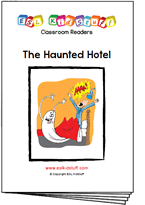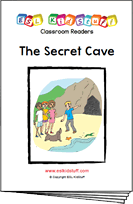Adverbs lesson plan
Stand-alone lesson ESL kids lesson plan
Lesson plans for ESL kids teachers
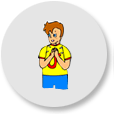
Adverbs
In this lesson students will learn how to modify verbs using adverbs. They will also do lots of energetic activities, sing a song and do a worksheet.
Members get accompanying worksheets, song and classroom reader.
Download materials:
Our lesson plans are FREE!
Sign up for accompanying:
✔ worksheets
✔ homework sheets
✔ craft sheets
✔ flashcards
✔ song downloads & videos
✔ classroom readers & videos
Click to see lesson details, materials and supplies
Time: 40 mins – 1 hour
Objectives: Saying actions with adverbs.
Structures: “Let’s ~”, “What shall we do?”
Target vocabulary: run, quickly, walk, slowly, jump, high, crouch down, low, [hide_on_uk]stomp[/hide_on_uk][hide_on_us]stamp[/hide_on_us], loudly, tip-toe, quietly, pat our heads, softly, clap, hard.
Lesson materials
Printables:
- Adverbs match worksheet
- Adverbs write worksheet
- Reader worksheet
- Let’s have some fun! (Adverbs song) song poster
Songs:
- Let’s have some fun! (Adverbs song)
Readers:
- The haunted hotel
Additional materials:
- Adverb vocab crossword
- Adverb vocab word search
- Find the adverb worksheet
Supplies:
- [hide_on_uk]colored[/hide_on_uk][hide_on_us]coloured[/hide_on_us] pencils
- slips of paper with the target verbs and adverbs written on, placed inside two boxes or hats
- board with marker / chalk
- device to play the song on
In this lesson students will use practice saying adverbs to modify verbs. It is an action-packed lesson with lots of action activities.
An adverb is a word that tell us in what way someone does something. It modifies a verb, an adjective or another adverb.
Examples:
- Maria speaks quietly. (the adverb “quietly” modifies the verb “speaks”)
- Paul is really handsome. (the adverb “really” modifies the adjective “handsome”)
- Yumi is working too slowly. (the adverb “too” modifies the adverb “slowly”)
This lesson focuses on the first type of adverb (adverbs which modify verbs).
Adverb forms
Adverbs come in regular and irregular forms:
- regular = adjective + ly (quick → quickly, soft → softly, loud → loudly)
- irregular e.g. fast -> fast, high → high, low → low, good → well
Lesson procedure:
Warm up and maintenance:
The beginning of your lesson is extremely important: this is where you set the tone of your lesson and get everyone in the right frame of mind for learning English. It is also an opportunity to check homework and review previous lessons.
Click for warm up suggestions for the start of your lessons
These activities can be done in the following order at the start of your lesson:

1. Greetings and name tags
Greet the students by name as they enter the classroom and gesture for them to sit down. Before class prepare some blank name tags (stickers or pin-on tags). Give these out and have everyone write their names and put their tags on. If you use pin-on tags, you can keep and give out every class.

2. Homework check
Check each student’s homework set in the last lesson. Ask each student some questions about their homework worksheet (e.g. “what [hide_on_uk]color[/hide_on_uk][hide_on_us]colour[/hide_on_us] is it?”), give lots of praise, and then put some kind of mark on the homework sheet (e.g. a sticker, a stamp or draw a smiley face). Finally, tell your students to put their homework back into their bags.
3. Review past lessons
Reviewing past lessons is very important – students need constant practice of new vocab, structures, songs, games and so on. Always review parts of your last lesson as well as some parts from other previous lessons. You can spend 5-10 minutes reviewing – it’s fine to recycle games and activities from your past lessons to review as kids enjoy playing familiar games (although be careful not to play a game to death!). See the section “Other ideas to include in your warm” below for ideas.
You can also include review activities in the main body of your lesson. Kids can have short attention spans so it’s good to be able to pull out lots of activities during different stages of the lesson.
Other ideas to include in your warm up:
Ball pass questions
This is good to review questions from previous lessons. Get everybody standing in a circle.

Round 1:
Take a ball and hold it and say, “My name is (you name)”. Then throw the ball to one student and say, “What’s your name?”. Students throw the ball around randomly, saying their names and asking for names.
Round 2:
This time ask a review question, e.g. “How many tables are there?”. Then throw the ball to a student who should answer, “There are (6) tables”. Help if necessary. Then that student throws the ball to another student and asks a “How many …?” question. Continue so everyone has a go. You can have multiple rounds with different topic questions.

Play “Spin the bottle”
Sit students in a circle with a bottle in the middle. Teacher spins the bottle. When it stops spinning the student it is pointing to has to answer a question. If the answer is correct then that student can spin the bottle. This is a good class warm up activity (e.g. How are you? What’s your [hide_on_uk]favorite[/hide_on_uk][hide_on_us]favourite[/hide_on_us] food? How’s the weather today?, etc.

Play “Vocabulary basketball”
This is a fun game which reviews vocabulary from previous lessons. You will need a basket (a trash can) and 2 balls (or 2 pieces of A4 paper scrunched up into balls).
Form 2 teams and line them up so that two players from each team are facing the front with the basket in front of them. Let both players throw their ball – if they get their ball into the basket they can try and win a point by giving the correct answer to a question the teacher asks. This can be an actual question (e.g. What are you wearing?) or a flashcard (What’s this?). Then they go to the back of the line. At the end, the team with the most points is the winner!
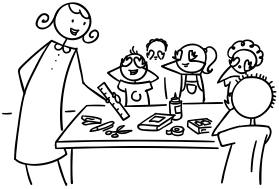
Play “What’s missing?”
This is a fun review memory game – students will have to try to remember review objects from previous lessons (e.g. classroom stationery). Lay the objects out on a table for all to see. Allow the students a minute to memorize the positions of the objects. Remove an object and hold it behind your back. Say, “Open your eyes!” – the first student who can shout out the missing object wins a point for his/her team. Play for all the objects.
Finally, calculate which team has won the most points and give them a round of applause.

Play “Quiz game show”
This is a fun quiz game, like a simple version of a TV game show. Draw some circles on the board and randomly write numbers 1, 2 or 3 in each circle. These will be points.
Put students into teams. Then ask the first team to choose a number – 1 is an easy question (e.g. “Do you like bananas?”) and 3 is a difficult question (e.g. point at a clock and ask, “What time is it?”). 2 will be in between in terms of difficulty. When the question has been answered correctly, erase that number circle. Play until all the number circles are gone – the team with the most points is the winner!
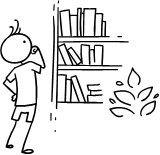
Read a classroom reader again
As you progress through the lessons you will start to build up a catalog of classroom readers (see our Readers download page at https://www.eslkidstuff.com). Kids love going back to old stories and reading through them again. Invite a student to pick a classroom reader and read through it as a class. Make the story as interactive as possible by asking questions (e.g. what [hide_on_uk]colors[/hide_on_uk][hide_on_us]colours[/hide_on_us] there are, the names of different objects, etc.) and getting students to speculate what is going to happen next in the story.

Talk about the weather (do after you have taught the weather lesson plan).
- Prepare a weather board. Before the first class prepare a piece of cardboard and cover it with felt – you are going to pin this to the wall. If you can, try and get blue felt (to represent the sky). Write at the top in large letters, “How’s the weather today?”. Below that write “Today it’s”. Cut out weather pictures (such as our weather flashcards) and stick some velcro on the back. Arrange the weather pictures around the edge of the board and then put the board on the wall of your classroom. You can now use this weather board at the beginning of every lesson.
- Ask about the weather. Ask, “How’s the weather today?” and have students put up their hands. Allow one weather condition per student (e.g. “It’s rainy”) and have each student come up and put a weather picture on the weather board.
- Introduce more weather vocabulary. Depending on weather conditions, you can introduce more weather words (with pictures … you can get students to draw them), such as:
- stormy
- misty
- showery
- freezing
- humid
- frosty
- icy
- drizzly
New learning and practice:
1. Introduce the adverbs – do the “Train ride” activity
To begin, get everybody standing in a long line with their hands on the shoulders of the student in front of them – forming a train (it is worthwhile moving all desks and tables to the edge of the classroom before doing this). The teacher can go at the front of the train. Start off by choo-chooing around the classroom at a nice, easy pace.
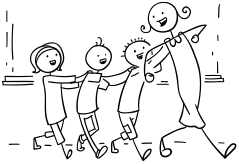
Then stop and say, “Let’s go again! This time count 1 and 2”. As you snake around the classroom, everyone shouts, “1, 2, 1, 2, …” together in time.
Now comes the fun part – introducing the adverbs. As the train is moving around the classroom, shout out the following commands and have everyone follow what you do:
- “Let’s go quickly!” – speed up – also speed up chanting “1, 2, 1, 2, …”.
- “Let’s go slowly!” – slow right down to a very slow pace and also slow down chanting “1 … 2 … 1 … 2 …”.
- “Let’s go high!” – put your hands high up in the air as the train moves around the class.
- “Let’s go low!” – bring your hands down low and stoop your head low as the train moves around the class.
- “Let’s count loudly!” – shout “1, 2, 1, 2, …” as the train moves around the class.
- “Let’s count quietly!” – whisper “1, 2, 1, 2, …” as the train moves around the class.
- “Let’s [hide_on_uk]stomp[/hide_on_uk][hide_on_us]stamp[/hide_on_us] hard!” – [hide_on_uk]stomp[/hide_on_uk][hide_on_us]stamp[/hide_on_us] your feet as the train moves around the class.
- “Let’s walk softly!” – walk as softly as you can as the train moves around the class.
Keep moving around the class and changing the instructions. It is great fun and an exciting way to begin the lesson.
2. Play “Follow my actions”
For this activity you are going to introduce the verbs from the song (which we’ll sing next). Your students should know some of the verbs (e.g. run, jump) and the others are easy to pick up quickly.
Get everyone to stand up and find a bit of space in the room. Teacher stands at the front of the classroom with everyone facing you. You are going to shout out the verbs from the song and act out the verbs, with everyone following you (doing the actions on the spot):
- run (on the spot)
- walk (on the spot)
- jump
- crouch down (on the spot)
- [hide_on_uk]stomp[/hide_on_uk][hide_on_us]stamp[/hide_on_us] (on the spot)
- tip-toe (on the spot)
- pat our heads
- clap
Each time you shout out the verb, students should chorus the verb and do the action with you, for example:
Teacher: “run”
Students: “run” (everyone starts running on the spot)
Teacher: “crouch down”
Students: “crouch down” (everyone crouches down)
Teacher: “tip-toe”
Students: “tip-toe” (everyone tip-toes on the spot)
etc.
We’ll do this activity in rounds:
- Round 1: the teacher does each activity with the students (until everyone can understand the verbs)
- Round 2: this time the teacher shouts out each action but only the students do the actions (and chorus the verbs). Teacher watches and helps out of necessary.
- Round 3: this time the teacher does the actions again and introduces the adverbs from the song – everyone must chorus each verbs + adverb and copy the teacher (e.g. “run quickly”, “pat our heads softly”, “jump high”, etc.)
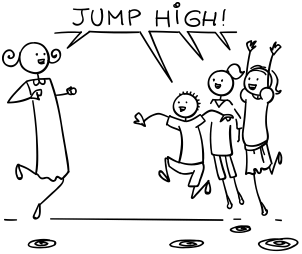
- Round 4: finally, the teacher shouts out the verbs + adverbs from the song without doing the actions and the students chorus and do the actions. Teacher watches and helps out if necessary.
3. Sing the “Let’s have some fun!” song
By now, your students should have a good grasp on the target vocab which will be used in the song. To help, place the song poster on the board so that everyone will be able to see which order to sing and do the actions. Quickly elicit the vocab. Play the song and sing along doing the actions as you sing. The song speeds up for verses 3 and 4 which adds to the fun. Play 2 or 3 times.
Lyrics for “Let’s have some fun!”
Chorus:
What shall we do?
Let’s have some fun!
Verse 1:
Let’s run, run quickly (quickly, quickly)
Let’s walk, walk slowly (slowly, slowly)
Let’s jump, jump high (high, high)
Let’s crouch down low (low, low)
Chorus
Verse 2:
Let’s stomp, stomp loudly (loudly, loudly)
Let’s tip-toe quietly (quietly, quietly)
Let’s pat our heads (softly, softly)
Let’s clap, clap hard! (hard, hard)
Chorus
Verse 3:
Let’s run, run quickly (quickly, quickly)
Let’s walk, walk slowly (slowly, slowly)
Let’s jump, jump high (high, high)
Let’s crouch down low (low, low)
Chorus
Verse 4:
Let’s stomp, stomp loudly (loudly, loudly)
Let’s tip-toe quietly (quietly, quietly)
Let’s pat our heads (softly, softly)
Let’s clap, clap hard! (hard, hard)
Gestures for “Let’s have some fun!”
The gestures for this songs are straight forward – simply have everyone do the actions as they sing them. The 3rd and 4th verses are faster versions of the 1st and 2nd verses (the song tempo speeds up).
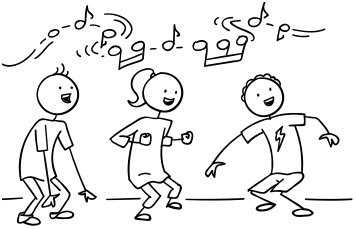
[hide_on_uk]Short sample (members get full-length song):
[/hide_on_uk]
[hide_on_us]Short sample (members get full-length song):
[/hide_on_us]

4. Do the “Adverbs match” worksheet
Give out the worksheets and have everyone match up the pictures with the adverbs. Circulate as everyone is working away, and ask lots of questions (e.g. What’s this?, Can you pat your head softly?, etc.). When everyone has finished, go around the class asking everybody to do some actions from their worksheets.
5. Read classroom reader “The haunted hotel”
Before starting the last activity let’s have story time! Before class, download and print off the reader “The haunted hotel”. As you go through each page, point to the pictures and elicit what each ghost likes to do and also ask for the adverb to go with the action, for example:
Teacher: (pointing at the picture on page 3) What does this ghost like to do?
Students: Pat people!
Teacher: Yes, that’s right! Where is he patting them? (pointing to head and shoulder)
Students: On heads and shoulders!
Teacher: Yes! That’s right! Is he patting them hard?
Students: No, softly!
Teacher: Ok, let’s check (reading from page 3) “I like to pat people softly on their heads and shoulders to scare them!”. Yes, good job!
Get the students really involved in the story by asking lots of questions about different objects in the pictures and have them copy the actions that the ghosts are doing.
After reading the story, give out a reader worksheet to each student and have everyone fill in the missing adverbs/words. Then go through the answers as a class.
Alternatively, watch our video version of the reader (Internet connection required).
6. Play “Adverbs charades”
Before class, write out the target verbs and adverbs on slips of paper and place in 2 boxes or hats: in one box place the verbs and in the other place the adjectives. You can also add more verbs that you have covered in previous lessons (e.g. dance, cook, sing, hop, eat, etc.).
Start by modeling the game: pull out one slip of paper from the verbs box and another from the adverbs box. Then mime the action and everyone has to guess what the two words are. The combinations can be quite strange but this makes it even more fun.
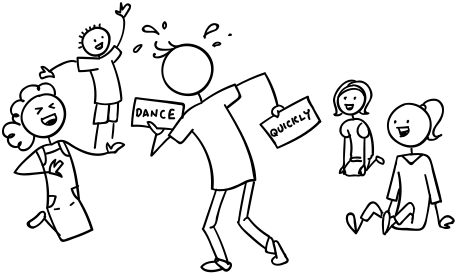
Split the class into 2 teams. Each time a student mimes the verbs + adverbs students can shout out the answer with the first correct one winning a point for their team. The winning student can then do the next charade. For younger students who have trouble reading, help by whispering in their ear.
Wrap up:
Assign homework: “Adverbs write” worksheet
Click for wrap up suggestions for the end of your lessons

1. Assign homework
Each week give out a homework worksheet for your students to take home. Hold up the homework worksheet and model how to do it. Give out the worksheets and say, “Put your homework in your bags”.

2. Do “Quick check”
Time to leave the class. Make sure everything is put away and the students have gathered their belongings. Have them line up at the door and place yourself between the door and the students. For each student check one new word or phrase, for example:
- hold up an object or flashcard (such as an item of clothing) and ask, “What’s this?”
- ask a question from the lesson (e.g. “Where do you live?”, “Do you like bananas?”, “Can you play chess?”, etc.)
When they give you the correct answer say goodbye and let them leave. If their answer is wrong, have them go back to the end of the line – they will have to try again once they reach the front!
Other lesson plans
Actions, verbs & tenses:
- Can – for ability
- Morning routines
- Daily routines & times of the day
- Actions – Present continuous
- Future plans using “going to”
- Past tense activities – Regular verbs
- Past tense activities – Irregular verbs: Part 1
- Past tense activities – Irregular verbs: Part 2
Adjectives:
- Describing people
- Describing things
- Comparing things (Comparative adjectives)
- Comparing things (Superlative adjectives)
Adverbs:
Alphabet:
Animals:
Body:
Classroom:
Clothes:
Colors:
Colours:
Directions:
Family:
Feelings & emotions:
Food:
Health & sickness:
Holidays & festivals:
Jobs:
Likes, dislikes & favorites:
Likes, dislikes & favourites:
- Likes & dislikes
- [hide_on_uk]Favorites[/hide_on_uk][hide_on_us]Favourites[/hide_on_us] and asking why
Nature & Our world:
Numbers:
Places & where we live:
Prepositions of location:
Pronouns:
Shapes:
Shopping:
Sports:
Time, days, months, seasons:
Toys:
Transport & travel:
Weather:


